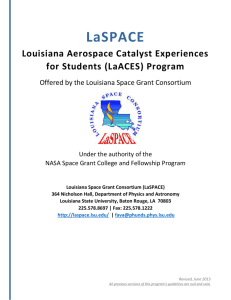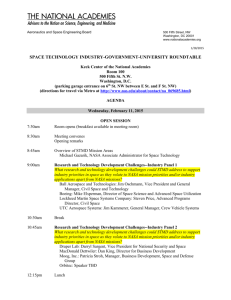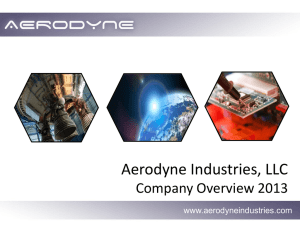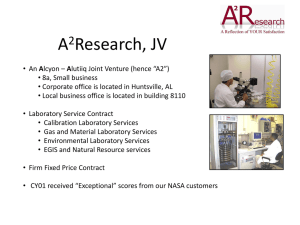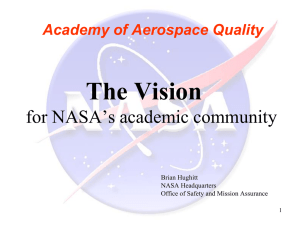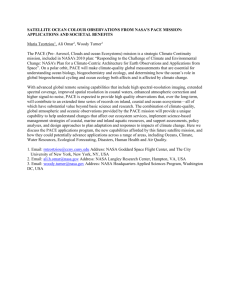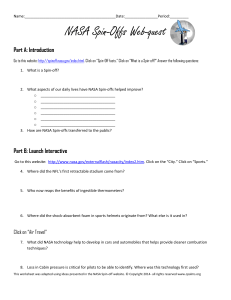Research Enhancement Award (REA) Program
advertisement
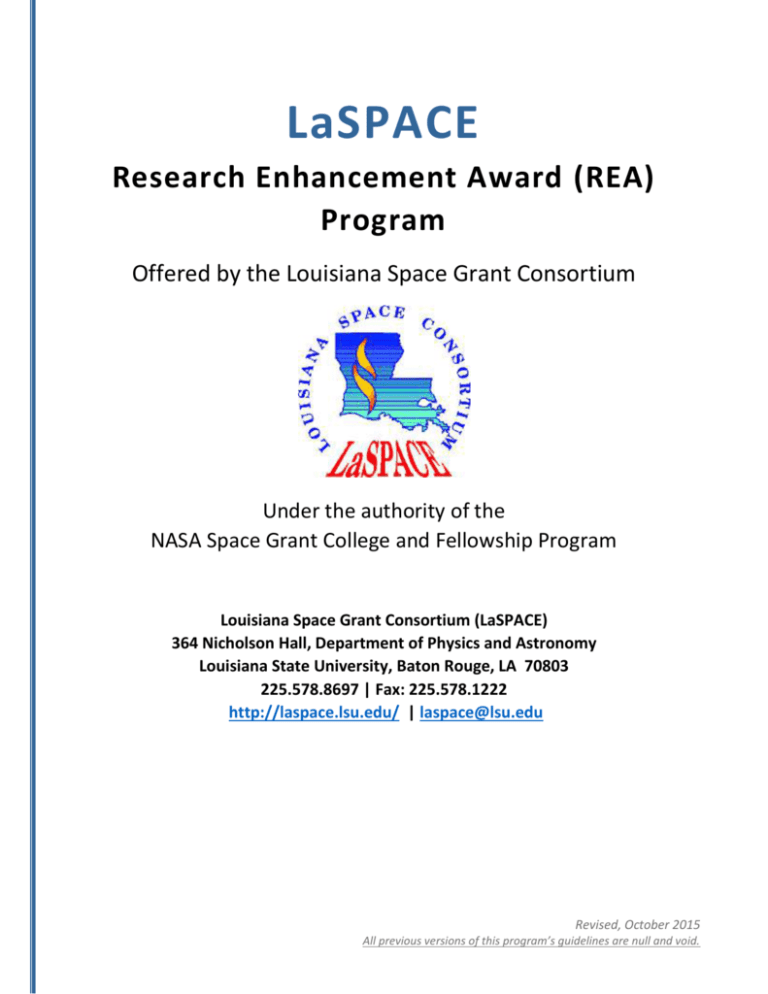
LaSPACE Research Enhancement Award (REA) Program Offered by the Louisiana Space Grant Consortium Under the authority of the NASA Space Grant College and Fellowship Program Louisiana Space Grant Consortium (LaSPACE) 364 Nicholson Hall, Department of Physics and Astronomy Louisiana State University, Baton Rouge, LA 70803 225.578.8697 | Fax: 225.578.1222 http://laspace.lsu.edu/ | laspace@lsu.edu Revised, October 2015 All previous versions of this program’s guidelines are null and void. REA Program Summary Page About Research Enhancement Awards (REA) The LaSPACE Research Enhancement Awards (REA) Program is intended to provide support for faculty (and students) at LaSPACE member institutions, particularly aimed at the emerging researcher or an established researcher who wishes to pursue new research directions, for the development of projects, contacts, and collaborations that will bring Louisiana scientists into the mainstream of NASA related research activity, thereby increasing their chances to successfully compete in the aerospace R&D marketplace. As is true with all LaSPACE Programs, minority participation is strongly encouraged. The REA Program is funded by state matching funds, through the Board of Regents Support Fund. The awards are intended to develop expertise and to contribute to research competitiveness. However, awards are not intended purely to support faculty salaries or graduate student stipends. It is anticipated (and strongly advised) that students (both graduate and undergraduate) will be involved in REA projects, but the overriding goal is the development of research capabilities and infrastructure in support of the country's space/aerospace endeavors. In that regard, contacts/collaborations/ties to NASA centers and NASA researchers are strongly encouraged Program Summary The overall goal for this Program is to effectively utilize the resources available through LaSPACE as incentive for faculty and students: 1) to develop research competitiveness 2) to develop new research projects or directions, and 3) to foster collaborations among the campuses, as well as with NASA centers and/or other federal laboratories and with the business/industry community. The REA Program is separated into two component parts or subprograms, The Research Facilitation/Initiation Subprogram and the Visiting Researcher Subprogram. Only tenure-track or research faculty at the level of Assistant Professor or higher affiliated with LaSPACE campuses are eligible to apply. In cases where support is requested for visiting scientists, the application must be submitted by, and be the responsibility of, a LaSPACE institution faculty member. All invoices and a final technical written must be submitted to the LaSPACE office within 30 days of the project end date. Photographs and copies of all papers, presentations, and posters generated should be shared with LaSPACE as they occur and collected/referenced in the final report. Updated Final Report Guidelines will be released in late Fall 2015 or early Spring 2016. Proposal Submissions Submit all properly executed proposals via email as fully searchable pdf documents to laspace@lsu.edu by 11:59 pm on Monday, December 7, 2015. Important Dates: o Proposal Release Date: Tuesday, October 27, 2015 o Proposal Due Date: Monday, December 7, 2015 o Anticipated Award Announcements: Mid-January 2015 o Anticipated Period of Performance: February 15, 2016 – February 14, 2017 LaSPACE REA Guidelines 2 LaSPACE General Guidelines Introduction to the Space Grant Program The Louisiana Space Grant Consortium (LaSPACE) is a Designated Consortium in the NASA National Space Grant College and Fellowship Program, which was designed to network colleges, universities, and state education boards with partners in business, industry, and the non-profit sector in order to promote, develop, and strengthen aerospace science, research, technology, education, and awareness. Our mission is “To enhance Space and Aerospace related research, education, and public awareness throughout the State of Louisiana and thereby promote math/science education, training of professionals, and economic development.” LaSPACE promotes scientific research, workforce development, and public outreach to develop and strengthen long-term research capabilities within Louisiana that will make significant contributions to the research and technology Mission Directorates of NASA while supporting the goals of the state. Basis of Authority The Louisiana Space Grant Consortium (LaSPACE) currently comprises Louisiana public and private colleges and universities in addition to business/industry partners and other organizations. The consortium is funded jointly by the National Aeronautics and Space Administration (NASA) and by the Louisiana Board of Regents Support Fund (BORSF). The consortium is administered by the LaSPACE Council, under the aegis of NASA and the Board of Regents. The basis of authority for this and other programs of LaSPACE rests in part on the above funding. It is important, therefore, to note that the implementation of LaSPACE-supported projects must conform to applicable Federal and State regulations, in general, and to the NASA stipulations, in particular. NASA Agency Information NASA Vision We reach for new heights and reveal the unknown for the benefit of humankind. NASA Mission Drive advances in science, technology, aeronautics, and space exploration to enhance knowledge, education, innovation, economic vitality, and stewardship of Earth. From the 2014 NASA Strategic Plan: NASA’s Vision and Mission statements remind us of our purpose and our path. NASA’s Vision leads to a future with an American-made launch capability supporting cutting-edge science, technology, and human exploration with strong technology and aeronautics programs. We will continue to push the frontier of space. We will develop new technologies for use in air, space, and on the ground. We will be a part of a strong, high-tech economy, and we will continue to partner with other nations to create a better world. We will increase our understanding of the universe and our place in it. Our Mission statement outlines our fundamental purpose and role in bringing that Vision to life. As the Nation’s leading organization for research and development in aeronautics and space, we are explorers and innovators who create and use our unique tools and capabilities for the benefit of the Nation and the world. LaSPACE REA Guidelines 3 Complete Plan available: http://www.nasa.gov/sites/default/files/files/2014_NASA_Strategic_Plan.pdf NASA Education NASA contributes to national efforts for achieving excellence in STEM education through a comprehensive education portfolio implemented by the Office of Education, the Mission Directorates, and the NASA Centers. NASA will continue the Agency’s tradition of investing in the Nation’s education programs and supporting the country’s educators who play a key role in preparing, inspiring, exciting, encouraging, and nurturing the young minds of today that will manage and lead the Nation’s laboratories and research centers of tomorrow. NASA Office of Education and Mission Directorates The National Space Grant College and Fellowship Program, from which LaSPACE is derived, is managed through the NASA Office of Education based at NASA Headquarters in Washington D.C., http://www.nasa.gov/offices/education/about/index.html. NASA's education program strives to "inspire and motivate students to pursue careers in science, technology, engineering, and mathematics" by supporting education in the Nation's schools and to "engage the public in shaping and sharing the experience of exploration and discovery" by supporting informal education and public outreach efforts. NASA identifies three major education goals: Strengthening NASA and the Nation's future workforce Attracting and retaining students in science, technology, engineering and mathematics, or STEM, disciplines Engaging Americans in NASA's mission Research and technology priorities are based on alignment with one or more of NASA’s Mission Directorates: The Aeronautics Research Mission Directorate (ARMD), http://www.aeronautics.nasa.gov/about_us.htm Human Exploration and Operations Mission Directorate (HEOMD), http://www.nasa.gov/directorates/heo/home/about.html#.VXtCQUZURmM Science Mission Directorate (SMD), http://science.nasa.gov/about-us/ Space Technology Mission Directorate (STMD), http://www.nasa.gov/directorates/spacetech/about_us/index.html All NASA subprograms must relate to and support one or more of these directorates. Likewise, all programs supported by LaSPACE must support the NASA organization, align with the NASA Strategic Plan, and support the goals of one or more directorates and the Office of Education. LaSPACE REA Guidelines 4 LaSPACE Program The Louisiana Space Grant Consortium, part of the National Space Grant College and Fellowship Program and in partnership with the Louisiana Board of Regents, supports programs at affiliated academic institutions and other Louisiana organizations that address the NASA mission, federal CoSTEM goals, and state education and economic priorities. LaSPACE programs for Research, Higher Education, Workforce Development, K-12 Teacher Development, and Public Outreach, strengthen the Science, Technology, Engineering, and Math (STEM) education needed for a diverse technical workforce, and develop the research and economic infrastructure to boost Louisiana’s contribution to the aerospace frontier. Goals and Objectives LaSPACE Goals and Objectives are directly aligned with NASA Office of Education (OE) Lines of Business (LOB) and National Program Emphases on Diversity, Workforce Development, Community Colleges, Pre-College teacher engagement, Competitiveness, NASA Research Relevance, Industry Relations, and State Government Involvement. The updated LaSPACE 2015 Strategic Plan (posted on our website) describes a comprehensive program of Research, Education, and Service via 5 strategic goals, each in line with one or more NASA OE LOB, to (1) Foster aerospace research and education (LOB 2&3), (2) Encourage aerospace industries within Louisiana (LOB 1), (3) Contribute to pre-college STEM education excellence (LOB 4), (4) Engage and educate the general public (LOB 3&4), and (5) Maintain an effective consortium of institutions involved in LaSPACE (LOB 1). Major objectives for the achievement of these goals includes (1) Support for student and faculty research at consortium institutions, (2) Strengthening interactions between Louisiana aerospace industries, faculty, and students, (3) Increased participation in Space Grant programming with the state’s HBCUs and Community & Technical Colleges, (4) Provide support to undergraduate and graduate students for research, design, and internship opportunities, (5) Engage students in experiential learning environments, (6) Support middle and high school educator training, and (7) Foster informal education and public outreach. Proposals to LaSPACE programs should explicitly support one or more of these seven objectives. LaSPACE Program Administration & Institutional Coordinators General administration and management is the responsibility of the LaSPACE Staff headquartered at Louisiana State University (LSU). Questions about applications to any LaSPACE programs should be directed to the Director or Program Manager. Unless otherwise directed, all proposals should be submitted via email to both the Director and the Program Manager at the email addresses included below. LaSPACE Program Office LSU Department of Physics & Astronomy 364 Nicholson Hall, Baton Rouge, LA 70803 Phone: 225.578.8697 Fax: 225.578.1222 T. Gregory Guzik, Director; Colleen H. Fava, Manager (laspace@lsu.edu) LaSPACE REA Guidelines 5 Additionally, all member institutions have appointed an institutional coordinator who sits on the LaSPACE Advisory Council and is available to discuss opportunities and processes related to LaSPACE programs. Contact information for all advisors is provided below. For institutions with a vacancy, contact the program manager listed above. LaSPACE Affiliate Institutional Coordinators Baton Rouge Community College (BRCC) Asoka Sekharan sekharan@mybrcc.edu 225-216-8118 Delgado Community College (DCC) Raymond Duplessis rduple@dcc.edu 504-671-6419 Dillard University (Dillard) Abdalla Darwish adarwish@dillard.edu 504-816-4840 BREC / Highland Road Park Observatory (HRPO) Christopher Kersey observatory@brec.org 225-768-9948 Cain Center for STEM Literacy (Cain Center) Brenda Nixon bnixon@lsu.edu 225-578-4082 Grambling State University (GSU) Matthew F. Ware waremf@gram.edu 318-274-2391 Jacobs Technology, Inc. at Michoud (Jacobs) Chip Howat carl.j.howat@nasa.gov 504-257-0478 Louisiana Arts and Science Museum (LASM) Jon Elvert jelvert@lasm.org 225-344-5272 La Board of Elementary & Secondary Education (BESE) Ann Wilson Ann.wilson@la.gov 225-342-0140 Louisiana Board of Regents (BOR) Jessica Patton jessica.domingue@la.gov 225-342-4253 Louisiana Business and Technology Center (LBTC) Roy Keller rkeller@lsu.edu 225-578-3985 Louisiana State University and A&M College (LSU) Ram Devireddy devireddy@me.lsu.edu 225-578-5891 Louisiana State University of Shreveport (LSU-S) vacant vacant vacant Louisiana State University Agricultural Center (LSU-Ag) Wade Baumgartner wbaumgartner@agcenter.lsu.edu 225-578-7742 Louisiana Tech University (LaTech) Niel Crews ncrews@latech.edu 318-257-5109 Loyola University (Loyola) Martin McHugh mmchugh@loyno.edu 504-865-2451 McNeese State University (McNeese) Ning Zhang nzhang@mcneese.edu 337-475-5873 Nicholls State University (Nicholls) Chadwick H. Young chad.young@nicholls.edu 985-448-4879 Northwestern State University of Louisiana (NWSU) Austin L. Temple Jr. temple@nsula.edu 318-357-6699 River Parishes Community College (RPCC) Esperanza Zenon ezenon@rpcc.edu 225-743-8713 SciPort Louisiana’s Science Center (SciPort) Ann S. Fumarolo afumarolo@sciport.org 318-242-3466 Southeastern Louisiana University (SELU) Nick Norton nnorton@selu.edu 985-549-3740 Southern University and A & M College (SUBR) Diola Bagayoko bagayoko@aol.com 225-771-2730 Southern University of New Orleans (SUNO) Illya Tietzel itietzel@suno.edu 504-286-5111 Tulane University (Tulane) Mark J. Fink fink@tulane.edu 504-862-3568 University of Louisiana at Lafayette (ULL) Afef Fekih afef.fekih@louisiana.edu 337-482-5333 University of Louisiana at Monroe (ULM) Leonard Clark leclark@ulm.edu 318-342-1036 University of New Orleans (UNO) Kevin L. Stokes klstokes@uno.edu 504-280-1038 Xavier University of Louisiana (Xavier) vacant vacant vacant LaSPACE REA Guidelines 6 LaSPACE Requirements and Restrictions In this section, requirements and restrictions applied to LaSPACE programs are summarized. Public Nature of Applications to LaSPACE Once an application is received in the LaSPACE office, it becomes public record. Although the staff will not disseminate applications to individuals other than to reviewers, applicants should be aware that, if a request for information is made by the public (e.g., the news media), a copy of the application, by law, must be provided. Disclosure of Information All LaSPACE programs must conform to applicable Federal, State and NASA regulations and stipulations. This includes annual reporting of award participant information to both the Louisiana Board of Regents and NASA. Part of this information will include both directory information such as name, address, telephone number, date of birth, and demographic information such as gender, ethnicity, and race for all award participants including faculty, staff, and students. Further, LaSPACE outreach includes public dissemination of its supported programs through The Spaceporter Newsletter, the LaSPACE website (http://laspace.lsu.edu/), as well as papers and/or presentations at Space Grant or related Education & Public Outreach conferences. The contents of award reports, including participant names, titles, institution, project summaries, results or conclusions and images, might be included in such public outreach articles. It is not intended that these public articles will disclose directory or demographic information except as aggregated statistical data. Diversity It is a national priority to increase diversity in Science, Technology, Engineering, and Mathematics (STEM), from university students, faculty, and staff to industry employees. Traditionally, minority groups and women have been under-represented in the STEM disciplines as students and faculty as well as in the workplace after graduation. LaSPACE is committed to addressing this priority and utilizing its programs, to the degree possible, to increase the diversity among its awardees. All proposers are encouraged to help recruit diverse participants to their proposed projects. Animal Use Any project proposing the use of an animal model for validation must include a local IACUC approval letter, fully signed, which specifies a validity period longer than the proposed project period. Failure to obtain the Institutional Animal Care and Use Committee’s approval in advance, is grounds for returning the proposal unreviewed. Attach the IACUC material as an additional appendix. Human Subjects Projects that involve human subjects are not acceptable for this program. Eligibility PI must be associated with a LaSPACE affiliated institution. PI must be a research or tenure-track faculty member or designated institutional representative recognized by LaSPACE. All NASA funded participants must be U.S. citizens. Additional, or altered, restrictions may apply to specific programs. LaSPACE REA Guidelines 7 Budgeting Capital Equipment purchases and Foreign Travel are, in general, not allowable costs. Disbursement of Funds LaSPACE Award fund distribution will be managed by the applicant's college or university, either via a cost-reimbursable subcontract if the applicant is at an affiliate other than LSU, or by transfer of funds from LaSPACE to the applicant's department for projects at LSU. The institution/department will assume responsibility for administering, distributing, and documenting costs charged to this program. Period of Performance Unless otherwise stated, LaSPACE programs have a default period of performance of no greater than 12 months. Shorter periods of performance may be proposed, or even required by the LaSPACE office, to meet any requirements or restrictions related to the parent grant. No cost extensions (NCEs) for ongoing projects may be submitted to the LaSPACE program office no later than 60 days before the initial project end-date. All NCE requests must include a status report which addresses all accomplishments made to-date on the project (including all publications, proposals, presentations, patents, etc), where the project is in relation to the originally proposed end date, reasons why the project has been delayed, and a proposed plan for completing the project. This status report must also identify all participants on the project and include demographics for each (students, post-docs, faculty, and staff). Number, Duration, and Funding of Awards LaSPACE expects to make varying numbers of awards in the subprograms of the Research Enhancement Awards Program. Historically, the Research Facilitation awards have been in the vicinity of $30-35K, while Visiting Researcher awards have been about $20K. These awards have generally been too small to support collaborative, inter-disciplinary projects among two or more LaSPACE campuses. Thus, we have established a larger award level up to ~$75,000 that will support a multi-institution project which may involve partnerships between a large, or majority, research-experienced institution and a minority/HBCU or small, non-research intensive institution. LaSPACE permits indirect (F & A) costs at the BOR rate (currently calculated as 25% of Salaries, Wages and Fringe) on all REA proposals. (Unrecovered F & A is an allowed form of cost sharing.) Further, a significant cost sharing by the submitting institutions and by collaborators is required (approximately 1:1). Cost sharing indicates an institution's commitment to the proposed project and is one of the criteria used by the reviewers in their evaluation. Further, LaSPACE is a federal-state partnership -- a 'seed' program -- that requires local matching funds to be generated. For a multi-institution project involving two or more LaSPACE affiliates, the match on the total project will be used for the evaluation. The lead institution could provide a 1:1 or greater match, while the smaller, collaborating institution could provide 1:1 or a match smaller than 1:1. Applications solely for the acquisition of equipment, or solely to support a graduate student, will not be funded. However, some support for graduate and undergraduate students is anticipated within an application. LaSPACE REA Guidelines 8 In the Research Facilitation/Initiation and Visiting Researchers Subprograms, funds are intended to be used to support research related activities of the participants. Research-related travel funds may be included in the budget, including conference registration fees to present results of LaSPACE funded research and/or for students to participate in a student paper/poster session. (Louisiana State travel regulations apply to all travel.) Equipment purchases of research-specific equipment may be allowed if sufficiently justified. Purchase of general office computers/software is not allowed unless it is specifically designated for the research, such as a dedicated laptop used on a research vessel, or the like. Other research-related expenditures will be considered on a case-by-case basis. Assessment by External Reviewers All applications that meet the eligibility requirements and guidelines established for this program will be reviewed by out-of-state consultants for merit. Applications will be rated based upon the extent to which they meet specific criteria and ranked in each subprogram, according to their scores on the following criteria. A strong proposal will clearly address each of the following: 1. Scientific and Technical merit of the proposed project. 2. Relevance of the project to aerospace goals and alignment with NASA and one of its Mission Directorates or Centers. 3. Competency of the project personnel with emphasis on the potential degree of enhancement and of the probability for the project to lead to increased competitiveness and subsequently funded work. 4. Degree to which new research directions and capabilities are to be developed. 5. Contribution of the project to increasing diversity, particularly under-represented groups, women, and persons with disabilities. 6. Degree to which the project will contribute to workforce development and 'human capital' needs, both locally and nationally. After receiving the recommendations of the out of state reviewers, LaSPACE will prepare a report on the evaluations for the Board of Regents (BoR). Once approved by the BoR, award letters will be issued and subcontracts will be drafted by the LSU Office of Sponsored Programs (OSP). Evaluation Criteria Each proposal submitted under the Research Enhancement Awards Program will be evaluated by out-ofstate reviewers from Space/Aerospace fields, but not generally by an expert in any particular subject area. Sufficient information must be clearly stated by the proposer to allow the reviewer to make an informed judgment. Failure to supply the appropriate information will lead to lower scores and nonfunding of the project. Proposals will be evaluated using the following criteria which are reflective of LaSPACE Goals and Objectives and the NASA Mission. 1. 2. 3. 4. The degree to which this proposal is relevant to Aerospace goals and to NASA’s Mission. (15%). Scientific and technical merit of the proposed project (25%). Competency of the proposer(s) to carry out the research plan and achieve the stated goals (10%). Probability for the project to develop new capabilities and its potential for increased involvement in Space or Aerospace R & D for the investigator(s) (10%). LaSPACE REA Guidelines 9 5. Adequacy of the project goals and objectives and the cited project outcomes (5%). 6. Appropriateness of the budget to carry out the project, including institutional contributions or other matching funds (10%). 7. Degree of student involvement in the Research Plan (10%). 8. Degree to which the project contributes to workforce and/or economic development (5%). 9. Contribution of the proposed project to increased diversity (10%). LaSPACE REA Guidelines 10 Research Enhancement Award (REA) Application Guidelines REA Program About Research Enhancement Awards (REA) The LaSPACE Research Enhancement Awards (REA) Program is intended to provide support for faculty (and students) at LaSPACE member institutions, particularly aimed at the emerging researcher or an established researcher who wishes to pursue new research directions, for the development of projects, contacts, and collaborations that will bring Louisiana scientists into the mainstream of NASA related research activity, thereby increasing their chances to successfully compete in the aerospace R&D marketplace. As is true with all LaSPACE Programs, minority participation is strongly encouraged. The REA Program is funded by state matching funds, through the Board of Regents Support Fund. The awards are intended to develop expertise and to contribute to research competitiveness. However, awards are not intended purely to support faculty salaries or graduate student stipends. It is anticipated (and strongly advised) that students (both graduate and undergraduate) will be involved in REA projects, but the overriding goal is the development of research capabilities and infrastructure in support of the country's space/aerospace endeavors. In that regard, contacts/collaborations/ties to NASA centers and NASA researchers are strongly encouraged The overall goal for this Program is to effectively utilize the resources available through LaSPACE as incentive for faculty and students: 1) to develop research competitiveness 2) to develop new research projects or directions, and 3) to foster collaborations among the campuses, as well as with NASA centers and/or other federal laboratories and with the business/industry community. Subprogram Descriptions The REA Program is separated into two component parts or subprograms, The Research Facilitation/Initiation Subprogram and the Visiting Researcher Subprogram. THE RESEARCH FACILITATION/ INITIATION AWARDS SUBPROGRAM is intended to support LaSPACE Goals with the objective to build research infrastructure. 1. To increase, in quantity and in quality, Louisiana's production of aerospace and related science and engineering graduates and professionals, 2. To enhance in scope, depth, and number, research and development activities in aerospace and related sciences and engineering, and 3. To indirectly increase aerospace and related industries in the state -- not only for economic development but also for economic diversification. THE VISITING RESEARCHERS SUBPROGRAM will provide funds to bring outside researchers to LaSPACE campuses for extended visits to work with faculty and students in developing new research directions. Funds may also be used to support a LaSPACE campus faculty member visiting another LaSPACE REA Guidelines 11 Louisiana campus or NASA Center, federal laboratory or business/industry, for the purpose of furthering research efforts. This Subprogram is not intended to support short colloquium/seminar trips but, rather, visits of weeks to months during which time significant progress can be made. Proposal Format Requirements All proposals submitted to LaSPACE must follow the format listed below. Proposals not constructed as follows may be rejected without review. Any forms mentioned below are included in the attachments following these guidelines. Cover Page Form Prior LaSPACE Awards Form Table of Contents Proposed Project Summary Form The project summary (abstract) must be 250 words or less. It should concisely describe the proposed project, giving the objectives, key features, and proposed outcomes, and provide a timetable for project implementation. The subprogram must be indicated underneath the title. Summaries are to be written in general terms, understandable by a non-expert in the field. Project Narrative The project narrative should be about ten (10) single-spaced pages (12 point font). Typical subsections of the narrative should include in the order listed, the following: Introduction: Indicate REA subprogram and state the technical or scientific problem to be addressed. Objectives of the Project: Scientific, technical objectives, workforce development, diversity objectives, and research capability development should be concisely delineated. Implementation Strategy or Scientific Method and Timetable: The scientific and technological methodology to be employed in the work should be succinctly described. Strategies germane to the successful implementation of the project should be discussed. A concise timetable, preferably in a tabular form, should be provided. Key milestones toward the successful completion and possible continuation and expansion of the project should be shown in this table along with measurable outcomes from the project. Relevance to NASA Mission: While direct collaboration with a NASA Center is not a requirement of the REA Program, it is desirable if possible. Previous or potential collaborations with NASA may be mentioned. Long Term Benefits: Describe the expected long range benefits from the project to Space and Aerospace R & D and infrastructure at the institution, as well as to the project personnel. Describe your plan for dissemination of the results. Discuss plans and prospects for submitting a follow-up proposal to NASA, other federal agencies, BORSF, or non-public sources. Describe patent potential, if applicable. LaSPACE REA Guidelines 12 Key Personnel/Management: Identify the key personnel and succinctly describe their qualifications and experiences as they relate to the successful execution, continuation, and expansion of the project. Discuss how the project contributes to creating a diverse workforce and meeting the human capital needs of government, industry and academia. Student Participants: NASA is strongly committed to the development of a strong aerospace workforce. Thus, it is strongly encouraged that undergraduate and/or graduate students be involved. NASA requires detailed longitudinal information on all participants, especially on students. Thus, the Final Technical Report must specify the student's: name, gender, ethnicity, matriculation level (F, S, J, S), major, contact information (e-mail, address, phone number), and, first job or graduate school if the student is graduating (see Appendix IV). Budget, Budget Explanations and Current/Pending Support Please provide the project budget on the Budget Form provided. Note that indirect is calculated at the BOR rate of 25% (salaries, wage and fringe). (Unrecovered indirect can be included as an institutional contribution; you will be required to document the institutional contributions in your financial reports.) Budget explanations, provided on a separate page, should be succinct but provide sufficient information for a reviewer to judge the need for and importance of the items requested. Following the budget, provide current and pending support information, for each Principal Investigator. Vita/Resume Attach a two page Vitae for each Principal Investigator. Letter of Support (if applicable) If the proposal involves work with a NASA center or other Federal laboratory or with a business-industry partner, attach a letter of support from the contact at the collaborating/participating institution (an e-mail is acceptable). A strong letter of support, describing the specific contributions in personnel or facility/laboratory use, will reflect well. Additional Format Requirements for Multi-Institutional Proposals A multi-institutional proposal will involve researchers at different LaSPACE affiliate campuses. Only one proposal is submitted and will be reviewed for funding. The Lead Institution must be clearly identified in the proposal. The lead proposal should include all items specified above, a completed “Multi-Institution Summary Page” plus a “Collaborator Proposal” for each collaborating campus. Further, the lead proposal must also include a discussion of how the multi-campus project will be managed. An extra page in the Project Narrative (total of 11) is allowed for this discussion. Finally, in the budget section the division of requested funds, match and/or subcontracts between campuses needs to be clearly explained. The individual awards contained in the subcontract total cost shown on the budget form should be identified in the budget justification and correspond to the total budget and match shown in the “Collaboration Proposal.” The “Collaboration Proposal” consists of a signed-off cover page, a “Multi-Institution Summary Page” indicating the lead institution and collaborating institution investigators, plus a narrative Statement of Work (SOW), identification of collaborating institution personnel and students, completed budget form and budget narrative. LaSPACE REA Guidelines 13 Notes for Success Remember, the reviewers will not be expert in all sub-fields. They will be generalists, usually faculty members at other universities. Avoid technical jargon as much as possible and write at a level for the average scientist/engineer in a clear and concise fashion, i.e. what has been called the "Scientific American Level." Keep in mind also that the proposal is your opportunity to present yourself in the most positive light and to emphasize your best points and accomplishments (and/or research career plans) in your research efforts. Any prior or planned contacts with NASA or aerospace-related institutions may be mentioned. Follow the format instructions and respond clearly to the requested information. Diversity and involving undergraduates or graduate students in the research, along with opportunities for student papers/posters or as co-authors is strongly encouraged. Review the Proposal Evaluation Criteria for additional hints for discussion points for a successful proposal. LaSPACE REA Guidelines 14 Attachments Required Proposal Forms Required Forms for Proposal All proposals submitted to LaSPACE must use the forms included following this page. Proposals not using these forms may be rejected without review. Cover Sheet Proposed Project Summary Prior LaSPACE Awards Proposal Budget Form Student Demographic Form (to be completed for proposed projects where the participating student(s) have already been identified; an updated version should be submitted with the final report AND upon request by LaSPACE staff). LaSPACE REA Program Proposal Cover Sheet 1. Title of Proposed Project: 2. Principal Investigator: (Name) (Highest Degree Earned) (Citizenship) (Department) 3. Institution of Higher Education: 4. Address: (Street Address/P.O. Box Number) (City, State) 5. Telephone: (Zip Code) FAX: E-mail: 6. Date of Submission: 7. Total Funds Requested: $ Institutional Match: $ ************************************************************************** Certification of Compliance with Applicable Executive Orders and U.S. Code: By signing and submitting this proposal, the signatories certify that the statements made in this proposal are true and complete to the best of their knowledge; they agree to comply with LaSPACE award terms and conditions if an award is made as a result of this proposal; and the institution and proposed project are in compliance with all applicable Federal and State laws and regulations including, but not limited to, Executive Order 12549, Debarment and Suspension, 34 CFR Part 85, Section 85.510, Participant's responsibilities; Non-Discrimination; Certification against Lobbying imposed by section 1352, title 31, U.S. Code; Compliance with China Funding Restriction as detailed in Public Laws 112-10 Section 1340(a) and 112-55, Section 539; ACORN Compliance in accordance with 534 of the Consolidated and Further Continuing Appropriations Act of 2012 (Pub. L.112-55); and does not have a federal tax liability or federal felony conviction (sections 544 and 543 of Public Law 112-55). 8. Signature of Principal Investigator: 9. Name of Authorized Institutional Rep: 10. Signature of Authorized Institutional Rep: 11. Date Signed: __________________________________________________________ Multi-Institution Proposals Indicate: ☐Lead Institution or ☐Subaward Institution Revised 10/2015 Proposed Project Summary NAME OF INSTITUTION (INCLUDE BRANCH/CAMPUS AND SCHOOL OR DIVISION, and DEPT) PRINCIPAL INVESTIGATOR NAME and ADDRESS (INCLUDE PHONE & EMAIL) PROJECT TITLE PROPOSED PROJECT START DATE ABSTRACT (DO NOT EXCEED 250 WORDS) Multi-Institution Proposed Project Summary NAME OF INSTITUTION (INCLUDE BRANCH/CAMPUS AND SCHOOL OR DIVISION, and DEPT) PRINCIPAL INVESTIGATOR NAME and ADDRESS (INCLUDE PHONE & EMAIL) Co-INVESTIGATOR INSTITUTION (DEPT), NAME, and ADDRESS (INCLUDE PHONE & EMAIL) PROJECT TITLE PROPOSED PROJECT START DATE ABSTRACT (DO NOT EXCEED 250 WORDS) Prior LaSPACE Awards For each prior LaSPACE award, as a PI or a Co-I please provide the following: 1. Project Title: 2. Dates: 3. Was a final technical report submitted? ______YES ______NO* If no, explain: 4. Did a proposal to a funding agency result? ______NO If yes, ______YES Agency: Title: Date: Status: ______Funded (Add additional pages as necessary.) ______Declined ______Pending LaSPACE REA Proposed Budget Form Include this form in your proposal. Be sure to only ascribe funds to categories explicitly open to the program area to which you are applying. Following this form, include a detailed narrative explanation of all proposed costs. Proposal Title: _________________________________________________________________ Principal Investigator: ___________________________________________________________ Institution: ____________________________________________________________________ LaSPACE Funds Requested Institutional Match Funds* 1. Researchers $ $ 2. Graduate Student(s) $ $ 3. Undergraduate Student(s) $ $ 4. Fringe Benefits $ $ 5. Subtotal A $ $ 1. Travel $ $ 2. Supplies & Materials $ $ 3. Communications $ $ 4. Equipment $ $ 5. Other Expenses (Identify) $ $ 6. Subcontracts $ $ $ $ $ $ $ $ A. Direct Labor B. Supportive Expenses 7. Subtotal B 8. F&A (Indirect) C. Total Project Cost *Must be certified on all financial billings/reports. Revised 06/2015 Student Information Form (The following is the information we must collect from all students participating in a LaSPACE SG or NASA EPSCoR program.) Date Completed/Submitted to LaSPACE: ________________________________ Name: _____________________________________________________ Date of Birth ______________ Permanent Address: _________________________________________________________________ _________________________________________________________________ Primary Telephone: ____________________ Primary e-mail: _____________________________ Secondary Telephone: _______________________ Secondary e-mail: ___________________________ University: _____________________________ Faculty advisor/mentor: ________________________ Advisor Phone: __________________________ Advisor E-mail: _______________________________ Project (circle one): GSRA LURA MRS Scholars Senior Design Intern LaACES HASP REA RAP Other (please explain): ____________________________________________________ U.S. Citizen: _____ Yes _____ No Gender: _____ M _____ F Hispanic/Latino: _____ Yes _____ No Race: ___________________________________________________________________ (African-American/Black; Asian; American Indian/Alaskan Native; Native Hawaiian; Pacific Islander; White) U.S. Military Service? _____ Yes _____ No Do you have a disability recognized under the American Disabilities Act? _____ Yes _____ No If yes, please list disability (write n/a, if you do not want to disclose): _____________________________________ Will you or your siblings be the first in your family to graduate from college? _____ Yes _____ No Undergraduate Student: _____ Yes _____ No Year in School: __________ Major: __________________ Anticipated Graduation (mo./yr.): ______________ (freshman/sophomore/junior/senior) What do you intend to do after you graduate? ___________________________________________________________________________________________ Graduate Student: _____ Yes _____ No Degree Sought: _________ Dept/Major: ____________________ Anticipated Graduation (mo./yr.): ______________ What do you intend to do after you graduate? ___________________________________________________________________________________________ Revised 06/2015
